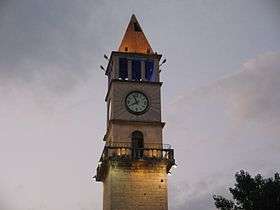Clock Tower of Tirana
| Clock Tower of Tirana | |
|---|---|
| Kulla e Sahatit | |
|
| |
| General information | |
| Type | Tower |
| Address | Rruga 28 Nentori |
| Town or city | Tirana |
| Country | Albania |
| Coordinates | 41°19′40″N 19°49′11″E / 41.327798°N 19.819783°E |
| Completed | 1822 |
| Renovated | 26 August 2009[1] |
| Owner | Municipality of Tirana |
| Height | |
| Top floor | 35 m (115 fl) |
The Clock Tower of Tirana (Albanian: Kulla e Sahatit), was built in Tirana, Albania in 1822 by Haxhi Et'hem Bey, a Bejtexhinj poet who also finished the building of the Et'hem Bey Mosque next to the clock tower.[2] It is a monument of culture of first category, approved on 24 May 1948.
The stairs have 90 steps that go in a spiral fashion. It is 35 metres (115 ft) tall and was the tallest building in Tirana at the time.
History
The clock tower was built by the Ottoman Turks and originally had a bell from Venice that marked the time every hour. In 1928 the Municipality of Tirana purchased a new clock in Germany to replace the existing one.[2] The clock was destroyed by bombardments during World War II and was replaced in 1946 with a Roman numeral clock from a church in Shkoder, Albania.[2] In 1970 the Roman numeral clock was replaced by a Chinese clock. The tower underwent renovation in 1981 and also in 1999. Access to the top of the tower has been available free of charge since 1996.[2]
A new restoration is ongoing by The Municipality of Tirana in 2010 for tourists.[2]
Architecture
Its base (ground floor) is squared and in the upper part of the premises are the mechanism and the bell of clock. The clock tower has only a gate for entrance. The lower part was built with thick stone wall bearing wooden stairs that lead to the upper part of tower. Its lighting is realized by narrow windows as turrets. On the upper part of the floor is set the clock mechanism. Modification of the mechanism from clock with sound in mechanized field clock has brought changes to the original appearance of this clock tower. This intervention was made in 1928, rebuilding the upper floors like we see today. It was last restored on 2016 by the Municipality.
Gallery
External links
- Kulla e Sahatit (Albanian)

